Project Environment Critical Analysis Labuan Square
VerifiedAdded on 2022/09/09
|22
|2986
|23
AI Summary
Contribute Materials
Your contribution can guide someone’s learning journey. Share your
documents today.

Project Environment Critical Analysis – Labuan Square Redevelopment
Secure Best Marks with AI Grader
Need help grading? Try our AI Grader for instant feedback on your assignments.

Executive Summary
This project is unique as it has two parts, demolition and construction. This report will critically
look at all the factors that will affect the project in both the two parts as well as mitigation
procedures that can be undertaken.
ii
This project is unique as it has two parts, demolition and construction. This report will critically
look at all the factors that will affect the project in both the two parts as well as mitigation
procedures that can be undertaken.
ii
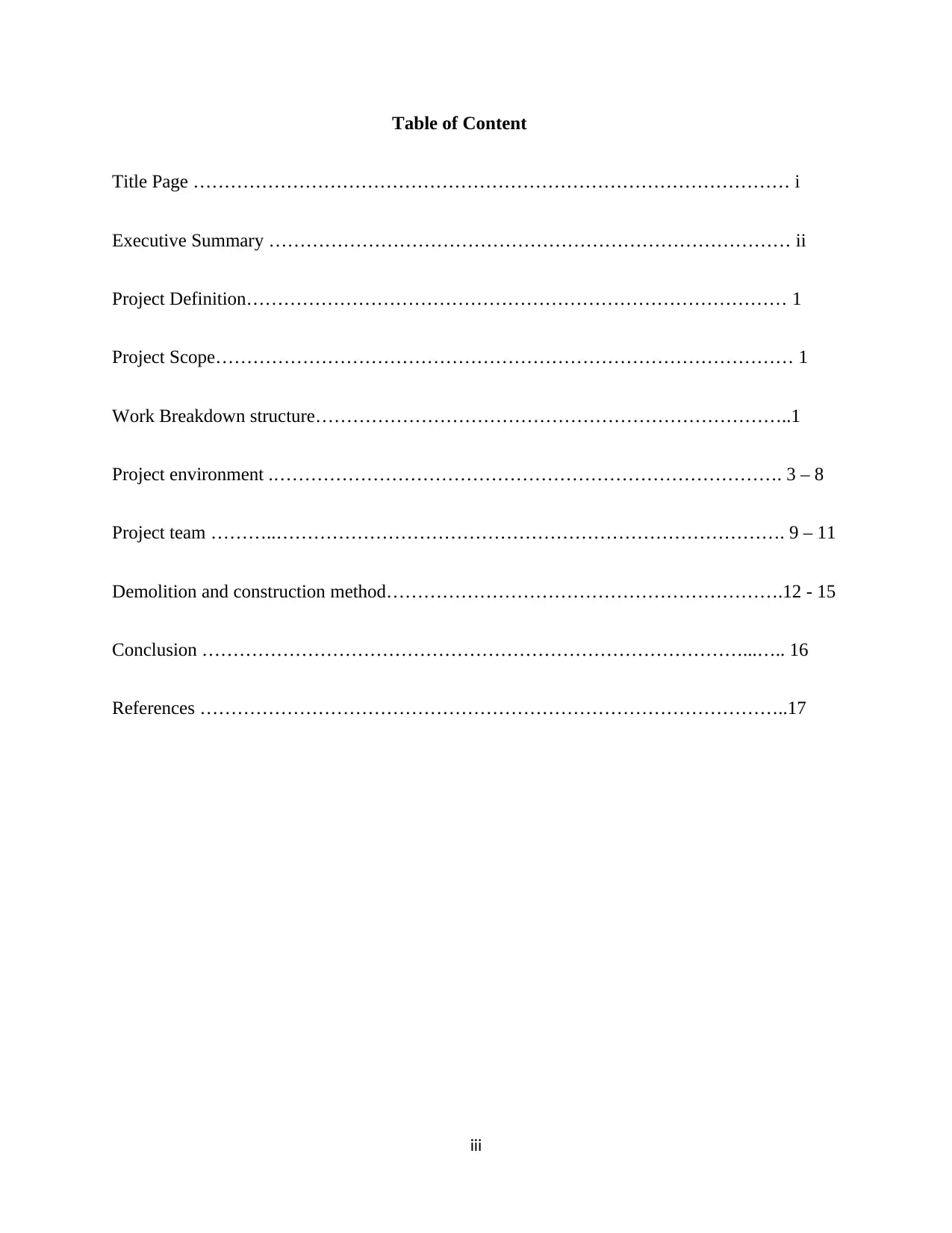
Table of Content
Title Page …………………………………………………………………………………… i
Executive Summary ………………………………………………………………………… ii
Project Definition…………………………………………………………………………… 1
Project Scope………………………………………………………………………………… 1
Work Breakdown structure…………………………………………………………………..1
Project environment .………………………………………………………………………. 3 – 8
Project team ………..………………………………………………………………………. 9 – 11
Demolition and construction method……………………………………………………….12 - 15
Conclusion ……………………………………………………………………………...….. 16
References …………………………………………………………………………………..17
iii
Title Page …………………………………………………………………………………… i
Executive Summary ………………………………………………………………………… ii
Project Definition…………………………………………………………………………… 1
Project Scope………………………………………………………………………………… 1
Work Breakdown structure…………………………………………………………………..1
Project environment .………………………………………………………………………. 3 – 8
Project team ………..………………………………………………………………………. 9 – 11
Demolition and construction method……………………………………………………….12 - 15
Conclusion ……………………………………………………………………………...….. 16
References …………………………………………………………………………………..17
iii
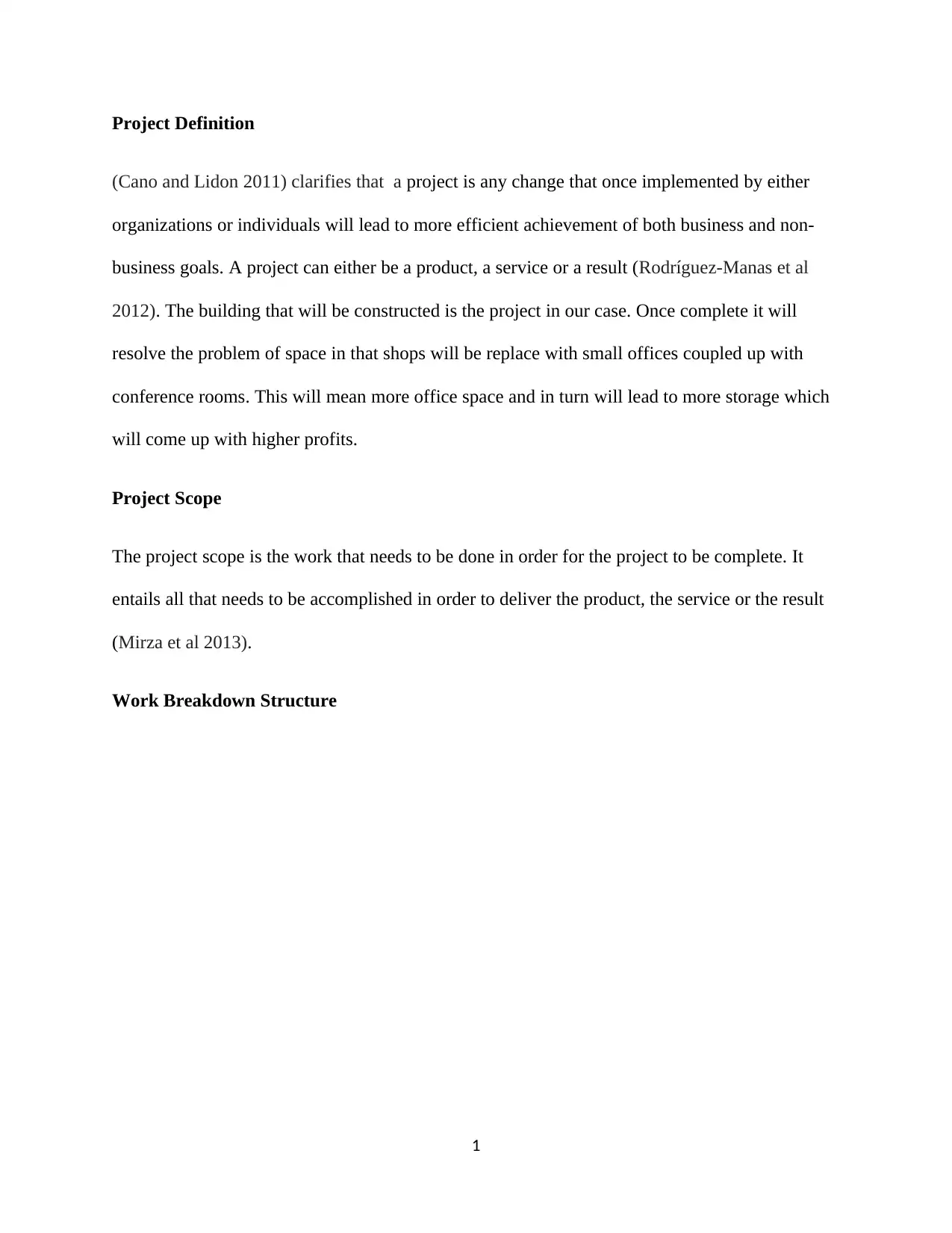
Project Definition
(Cano and Lidon 2011) clarifies that a project is any change that once implemented by either
organizations or individuals will lead to more efficient achievement of both business and non-
business goals. A project can either be a product, a service or a result (Rodríguez-Manas et al
2012). The building that will be constructed is the project in our case. Once complete it will
resolve the problem of space in that shops will be replace with small offices coupled up with
conference rooms. This will mean more office space and in turn will lead to more storage which
will come up with higher profits.
Project Scope
The project scope is the work that needs to be done in order for the project to be complete. It
entails all that needs to be accomplished in order to deliver the product, the service or the result
(Mirza et al 2013).
Work Breakdown Structure
1
(Cano and Lidon 2011) clarifies that a project is any change that once implemented by either
organizations or individuals will lead to more efficient achievement of both business and non-
business goals. A project can either be a product, a service or a result (Rodríguez-Manas et al
2012). The building that will be constructed is the project in our case. Once complete it will
resolve the problem of space in that shops will be replace with small offices coupled up with
conference rooms. This will mean more office space and in turn will lead to more storage which
will come up with higher profits.
Project Scope
The project scope is the work that needs to be done in order for the project to be complete. It
entails all that needs to be accomplished in order to deliver the product, the service or the result
(Mirza et al 2013).
Work Breakdown Structure
1
Secure Best Marks with AI Grader
Need help grading? Try our AI Grader for instant feedback on your assignments.
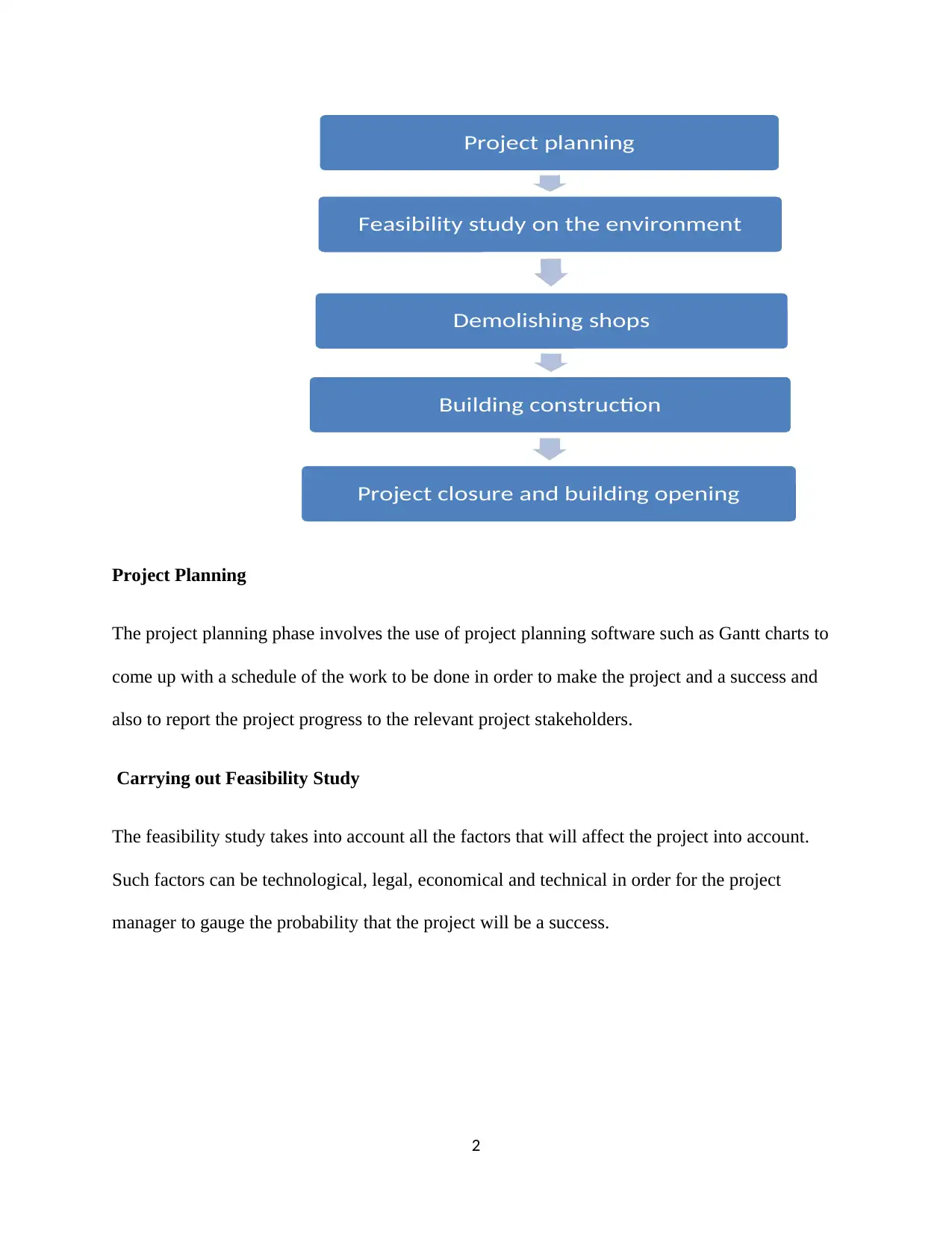
Project Planning
The project planning phase involves the use of project planning software such as Gantt charts to
come up with a schedule of the work to be done in order to make the project and a success and
also to report the project progress to the relevant project stakeholders.
Carrying out Feasibility Study
The feasibility study takes into account all the factors that will affect the project into account.
Such factors can be technological, legal, economical and technical in order for the project
manager to gauge the probability that the project will be a success.
2
Project planning
Feasibility study on the environment
Demolishing shops
Building construction
Project closure and building opening
The project planning phase involves the use of project planning software such as Gantt charts to
come up with a schedule of the work to be done in order to make the project and a success and
also to report the project progress to the relevant project stakeholders.
Carrying out Feasibility Study
The feasibility study takes into account all the factors that will affect the project into account.
Such factors can be technological, legal, economical and technical in order for the project
manager to gauge the probability that the project will be a success.
2
Project planning
Feasibility study on the environment
Demolishing shops
Building construction
Project closure and building opening
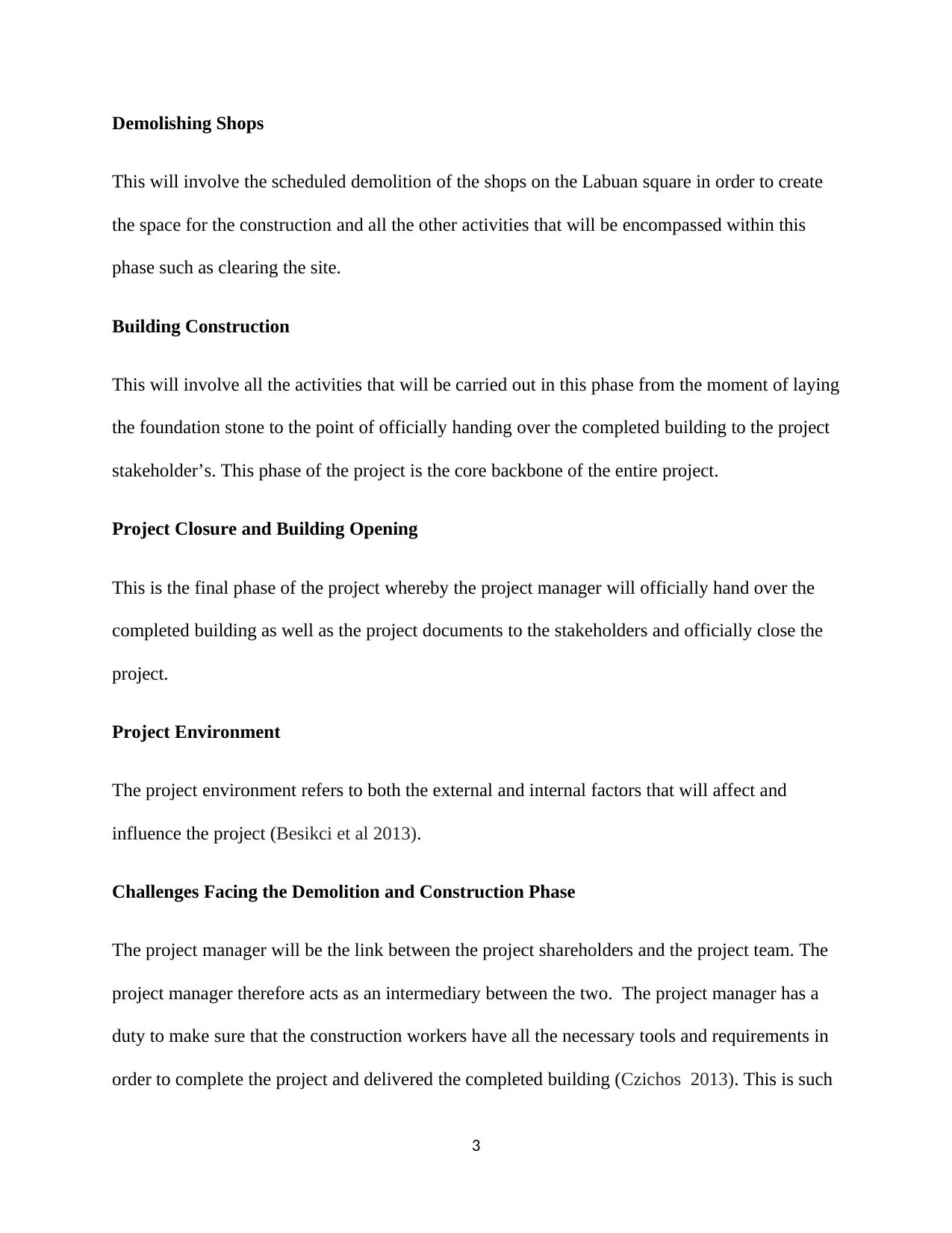
Demolishing Shops
This will involve the scheduled demolition of the shops on the Labuan square in order to create
the space for the construction and all the other activities that will be encompassed within this
phase such as clearing the site.
Building Construction
This will involve all the activities that will be carried out in this phase from the moment of laying
the foundation stone to the point of officially handing over the completed building to the project
stakeholder’s. This phase of the project is the core backbone of the entire project.
Project Closure and Building Opening
This is the final phase of the project whereby the project manager will officially hand over the
completed building as well as the project documents to the stakeholders and officially close the
project.
Project Environment
The project environment refers to both the external and internal factors that will affect and
influence the project (Besikci et al 2013).
Challenges Facing the Demolition and Construction Phase
The project manager will be the link between the project shareholders and the project team. The
project manager therefore acts as an intermediary between the two. The project manager has a
duty to make sure that the construction workers have all the necessary tools and requirements in
order to complete the project and delivered the completed building (Czichos 2013). This is such
3
This will involve the scheduled demolition of the shops on the Labuan square in order to create
the space for the construction and all the other activities that will be encompassed within this
phase such as clearing the site.
Building Construction
This will involve all the activities that will be carried out in this phase from the moment of laying
the foundation stone to the point of officially handing over the completed building to the project
stakeholder’s. This phase of the project is the core backbone of the entire project.
Project Closure and Building Opening
This is the final phase of the project whereby the project manager will officially hand over the
completed building as well as the project documents to the stakeholders and officially close the
project.
Project Environment
The project environment refers to both the external and internal factors that will affect and
influence the project (Besikci et al 2013).
Challenges Facing the Demolition and Construction Phase
The project manager will be the link between the project shareholders and the project team. The
project manager therefore acts as an intermediary between the two. The project manager has a
duty to make sure that the construction workers have all the necessary tools and requirements in
order to complete the project and delivered the completed building (Czichos 2013). This is such
3
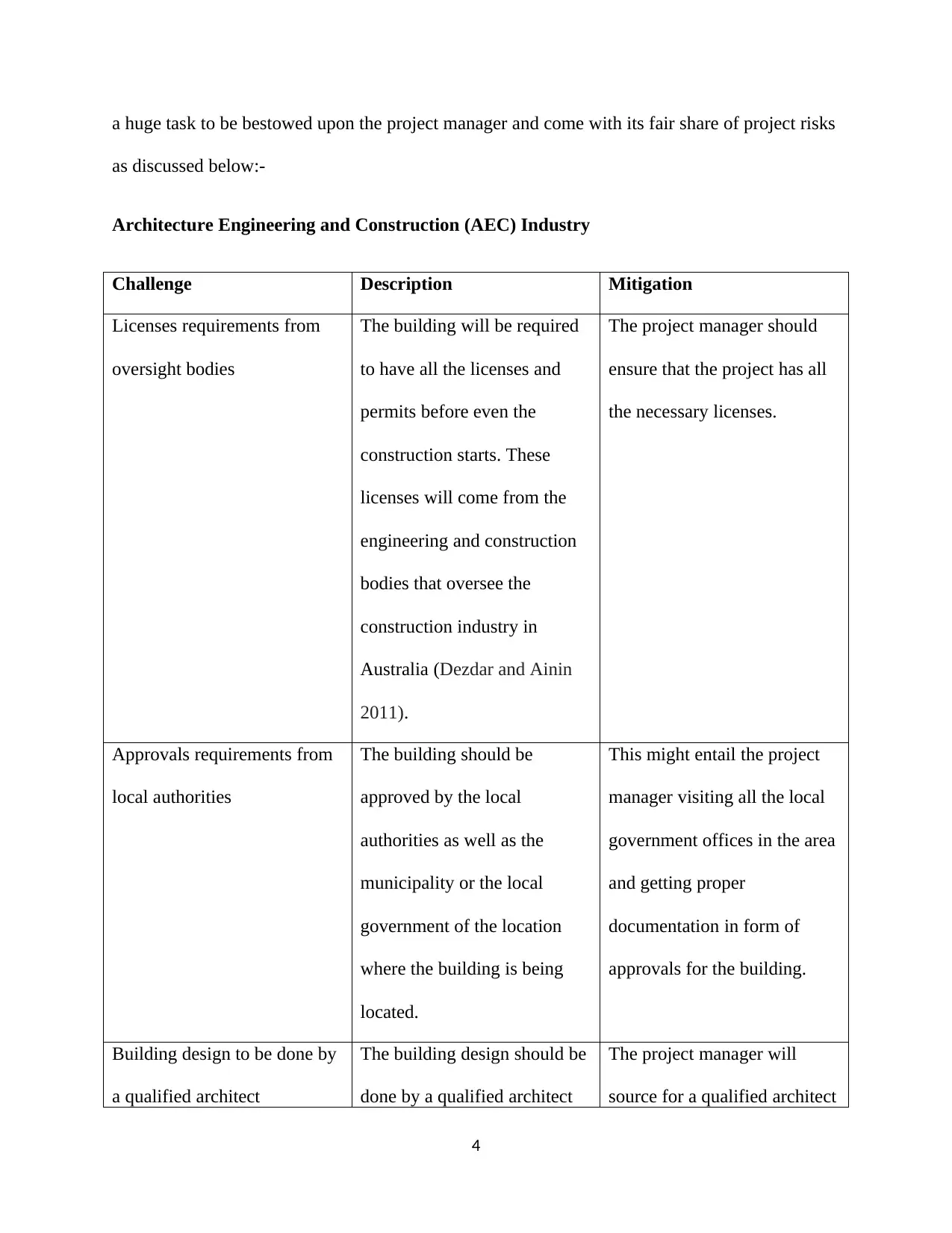
a huge task to be bestowed upon the project manager and come with its fair share of project risks
as discussed below:-
Architecture Engineering and Construction (AEC) Industry
Challenge Description Mitigation
Licenses requirements from
oversight bodies
The building will be required
to have all the licenses and
permits before even the
construction starts. These
licenses will come from the
engineering and construction
bodies that oversee the
construction industry in
Australia (Dezdar and Ainin
2011).
The project manager should
ensure that the project has all
the necessary licenses.
Approvals requirements from
local authorities
The building should be
approved by the local
authorities as well as the
municipality or the local
government of the location
where the building is being
located.
This might entail the project
manager visiting all the local
government offices in the area
and getting proper
documentation in form of
approvals for the building.
Building design to be done by
a qualified architect
The building design should be
done by a qualified architect
The project manager will
source for a qualified architect
4
as discussed below:-
Architecture Engineering and Construction (AEC) Industry
Challenge Description Mitigation
Licenses requirements from
oversight bodies
The building will be required
to have all the licenses and
permits before even the
construction starts. These
licenses will come from the
engineering and construction
bodies that oversee the
construction industry in
Australia (Dezdar and Ainin
2011).
The project manager should
ensure that the project has all
the necessary licenses.
Approvals requirements from
local authorities
The building should be
approved by the local
authorities as well as the
municipality or the local
government of the location
where the building is being
located.
This might entail the project
manager visiting all the local
government offices in the area
and getting proper
documentation in form of
approvals for the building.
Building design to be done by
a qualified architect
The building design should be
done by a qualified architect
The project manager will
source for a qualified architect
4
Paraphrase This Document
Need a fresh take? Get an instant paraphrase of this document with our AI Paraphraser
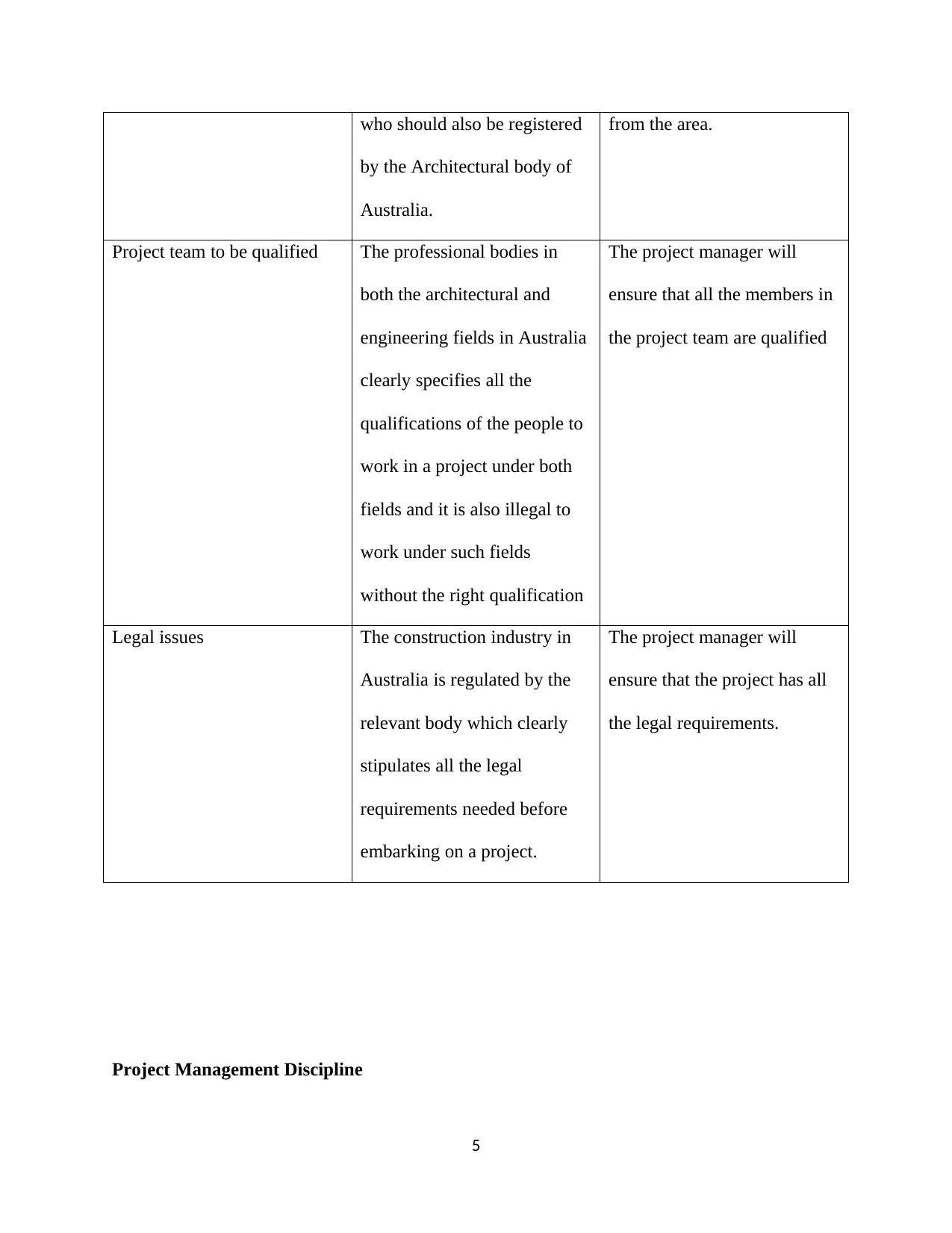
who should also be registered
by the Architectural body of
Australia.
from the area.
Project team to be qualified The professional bodies in
both the architectural and
engineering fields in Australia
clearly specifies all the
qualifications of the people to
work in a project under both
fields and it is also illegal to
work under such fields
without the right qualification
The project manager will
ensure that all the members in
the project team are qualified
Legal issues The construction industry in
Australia is regulated by the
relevant body which clearly
stipulates all the legal
requirements needed before
embarking on a project.
The project manager will
ensure that the project has all
the legal requirements.
Project Management Discipline
5
by the Architectural body of
Australia.
from the area.
Project team to be qualified The professional bodies in
both the architectural and
engineering fields in Australia
clearly specifies all the
qualifications of the people to
work in a project under both
fields and it is also illegal to
work under such fields
without the right qualification
The project manager will
ensure that all the members in
the project team are qualified
Legal issues The construction industry in
Australia is regulated by the
relevant body which clearly
stipulates all the legal
requirements needed before
embarking on a project.
The project manager will
ensure that the project has all
the legal requirements.
Project Management Discipline
5
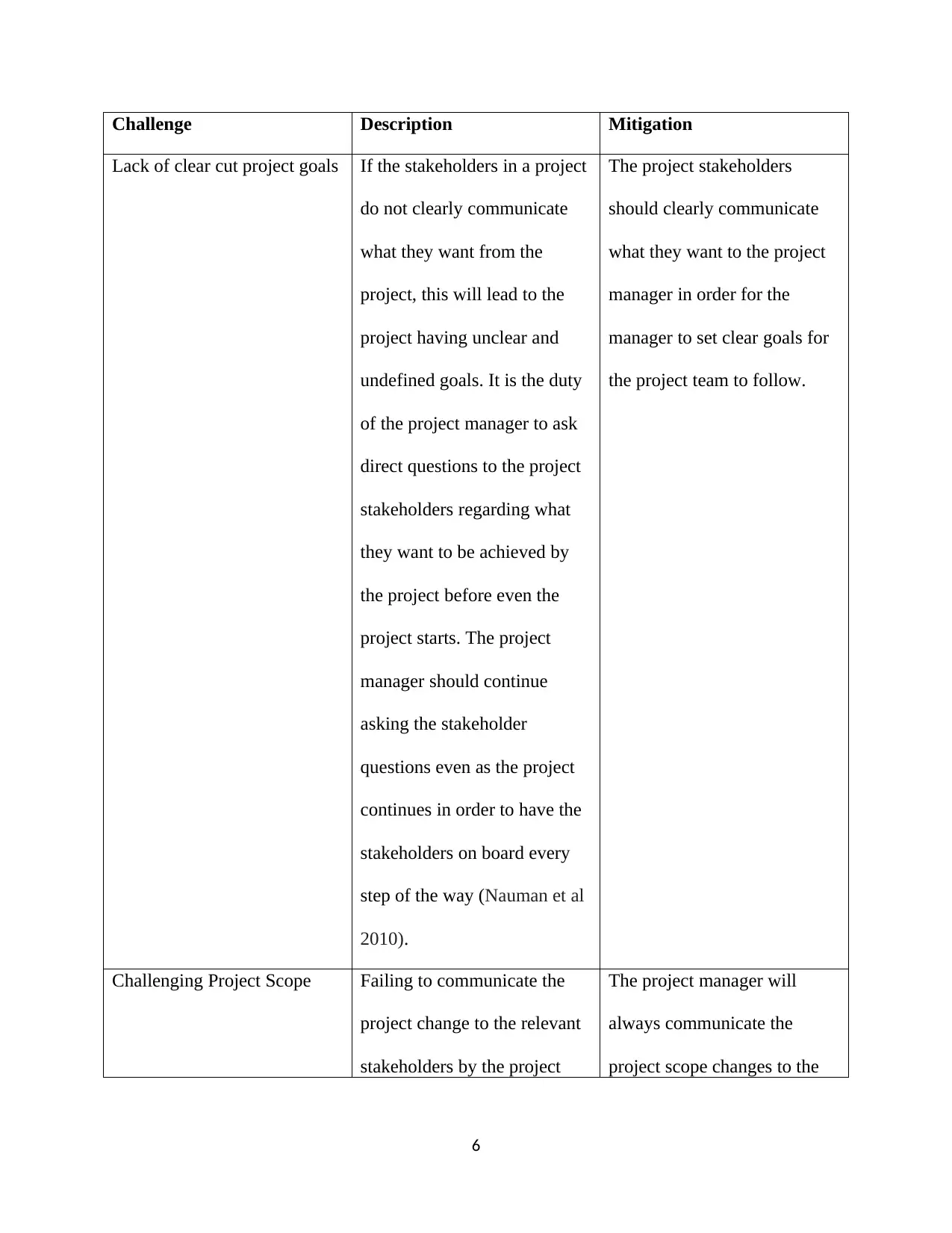
Challenge Description Mitigation
Lack of clear cut project goals If the stakeholders in a project
do not clearly communicate
what they want from the
project, this will lead to the
project having unclear and
undefined goals. It is the duty
of the project manager to ask
direct questions to the project
stakeholders regarding what
they want to be achieved by
the project before even the
project starts. The project
manager should continue
asking the stakeholder
questions even as the project
continues in order to have the
stakeholders on board every
step of the way (Nauman et al
2010).
The project stakeholders
should clearly communicate
what they want to the project
manager in order for the
manager to set clear goals for
the project team to follow.
Challenging Project Scope Failing to communicate the
project change to the relevant
stakeholders by the project
The project manager will
always communicate the
project scope changes to the
6
Lack of clear cut project goals If the stakeholders in a project
do not clearly communicate
what they want from the
project, this will lead to the
project having unclear and
undefined goals. It is the duty
of the project manager to ask
direct questions to the project
stakeholders regarding what
they want to be achieved by
the project before even the
project starts. The project
manager should continue
asking the stakeholder
questions even as the project
continues in order to have the
stakeholders on board every
step of the way (Nauman et al
2010).
The project stakeholders
should clearly communicate
what they want to the project
manager in order for the
manager to set clear goals for
the project team to follow.
Challenging Project Scope Failing to communicate the
project change to the relevant
stakeholders by the project
The project manager will
always communicate the
project scope changes to the
6
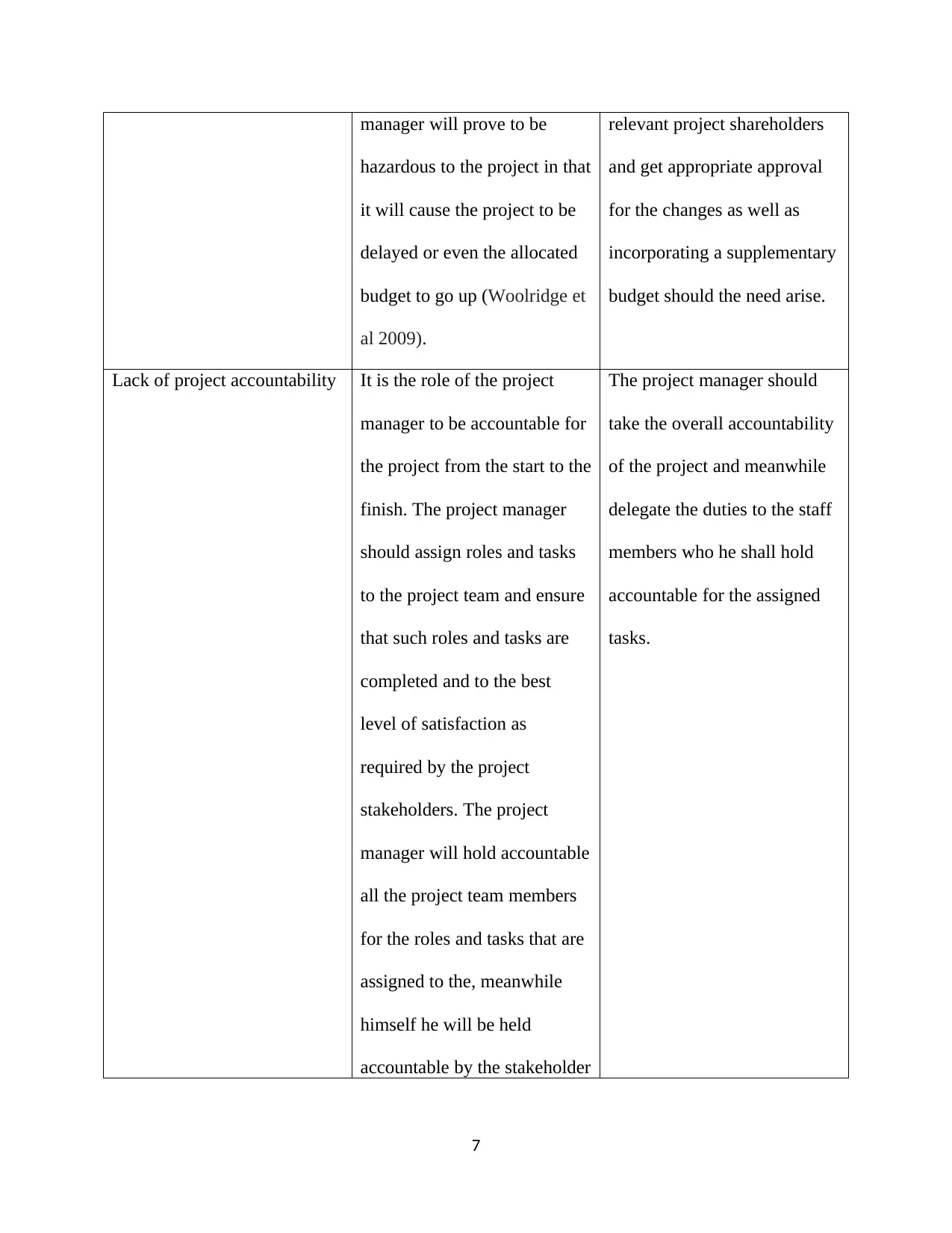
manager will prove to be
hazardous to the project in that
it will cause the project to be
delayed or even the allocated
budget to go up (Woolridge et
al 2009).
relevant project shareholders
and get appropriate approval
for the changes as well as
incorporating a supplementary
budget should the need arise.
Lack of project accountability It is the role of the project
manager to be accountable for
the project from the start to the
finish. The project manager
should assign roles and tasks
to the project team and ensure
that such roles and tasks are
completed and to the best
level of satisfaction as
required by the project
stakeholders. The project
manager will hold accountable
all the project team members
for the roles and tasks that are
assigned to the, meanwhile
himself he will be held
accountable by the stakeholder
The project manager should
take the overall accountability
of the project and meanwhile
delegate the duties to the staff
members who he shall hold
accountable for the assigned
tasks.
7
hazardous to the project in that
it will cause the project to be
delayed or even the allocated
budget to go up (Woolridge et
al 2009).
relevant project shareholders
and get appropriate approval
for the changes as well as
incorporating a supplementary
budget should the need arise.
Lack of project accountability It is the role of the project
manager to be accountable for
the project from the start to the
finish. The project manager
should assign roles and tasks
to the project team and ensure
that such roles and tasks are
completed and to the best
level of satisfaction as
required by the project
stakeholders. The project
manager will hold accountable
all the project team members
for the roles and tasks that are
assigned to the, meanwhile
himself he will be held
accountable by the stakeholder
The project manager should
take the overall accountability
of the project and meanwhile
delegate the duties to the staff
members who he shall hold
accountable for the assigned
tasks.
7
Secure Best Marks with AI Grader
Need help grading? Try our AI Grader for instant feedback on your assignments.
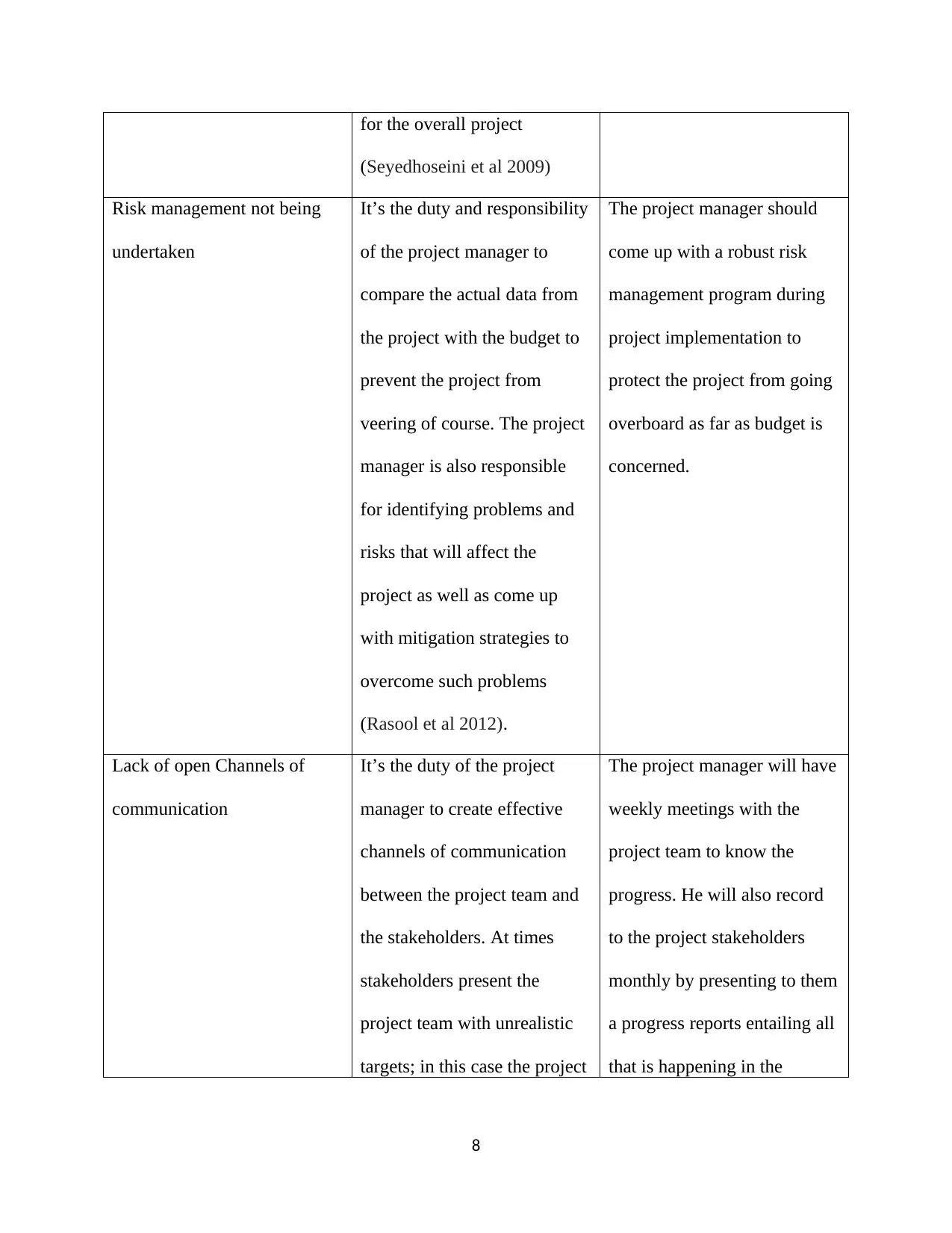
for the overall project
(Seyedhoseini et al 2009)
Risk management not being
undertaken
It’s the duty and responsibility
of the project manager to
compare the actual data from
the project with the budget to
prevent the project from
veering of course. The project
manager is also responsible
for identifying problems and
risks that will affect the
project as well as come up
with mitigation strategies to
overcome such problems
(Rasool et al 2012).
The project manager should
come up with a robust risk
management program during
project implementation to
protect the project from going
overboard as far as budget is
concerned.
Lack of open Channels of
communication
It’s the duty of the project
manager to create effective
channels of communication
between the project team and
the stakeholders. At times
stakeholders present the
project team with unrealistic
targets; in this case the project
The project manager will have
weekly meetings with the
project team to know the
progress. He will also record
to the project stakeholders
monthly by presenting to them
a progress reports entailing all
that is happening in the
8
(Seyedhoseini et al 2009)
Risk management not being
undertaken
It’s the duty and responsibility
of the project manager to
compare the actual data from
the project with the budget to
prevent the project from
veering of course. The project
manager is also responsible
for identifying problems and
risks that will affect the
project as well as come up
with mitigation strategies to
overcome such problems
(Rasool et al 2012).
The project manager should
come up with a robust risk
management program during
project implementation to
protect the project from going
overboard as far as budget is
concerned.
Lack of open Channels of
communication
It’s the duty of the project
manager to create effective
channels of communication
between the project team and
the stakeholders. At times
stakeholders present the
project team with unrealistic
targets; in this case the project
The project manager will have
weekly meetings with the
project team to know the
progress. He will also record
to the project stakeholders
monthly by presenting to them
a progress reports entailing all
that is happening in the
8
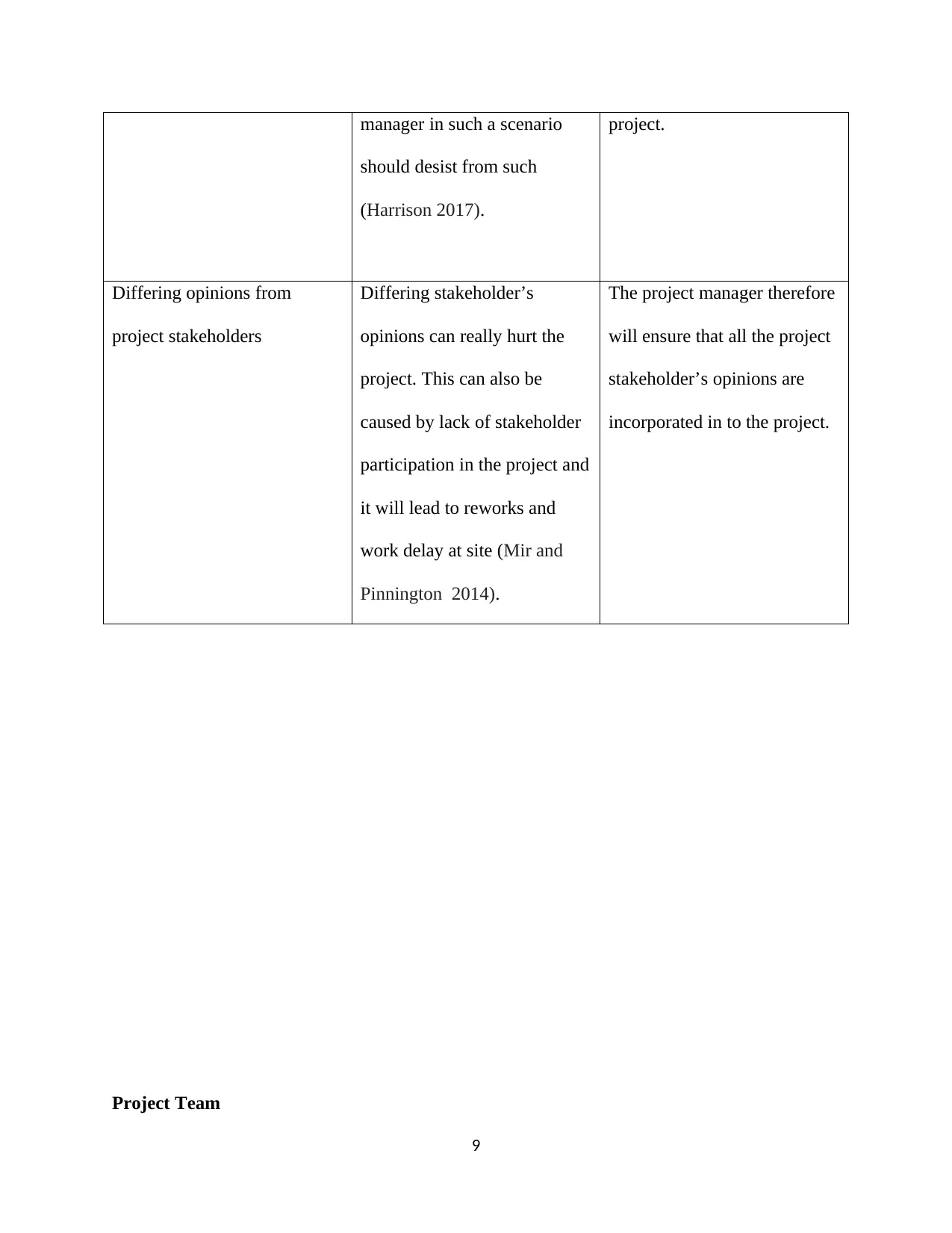
manager in such a scenario
should desist from such
(Harrison 2017).
project.
Differing opinions from
project stakeholders
Differing stakeholder’s
opinions can really hurt the
project. This can also be
caused by lack of stakeholder
participation in the project and
it will lead to reworks and
work delay at site (Mir and
Pinnington 2014).
The project manager therefore
will ensure that all the project
stakeholder’s opinions are
incorporated in to the project.
Project Team
9
should desist from such
(Harrison 2017).
project.
Differing opinions from
project stakeholders
Differing stakeholder’s
opinions can really hurt the
project. This can also be
caused by lack of stakeholder
participation in the project and
it will lead to reworks and
work delay at site (Mir and
Pinnington 2014).
The project manager therefore
will ensure that all the project
stakeholder’s opinions are
incorporated in to the project.
Project Team
9
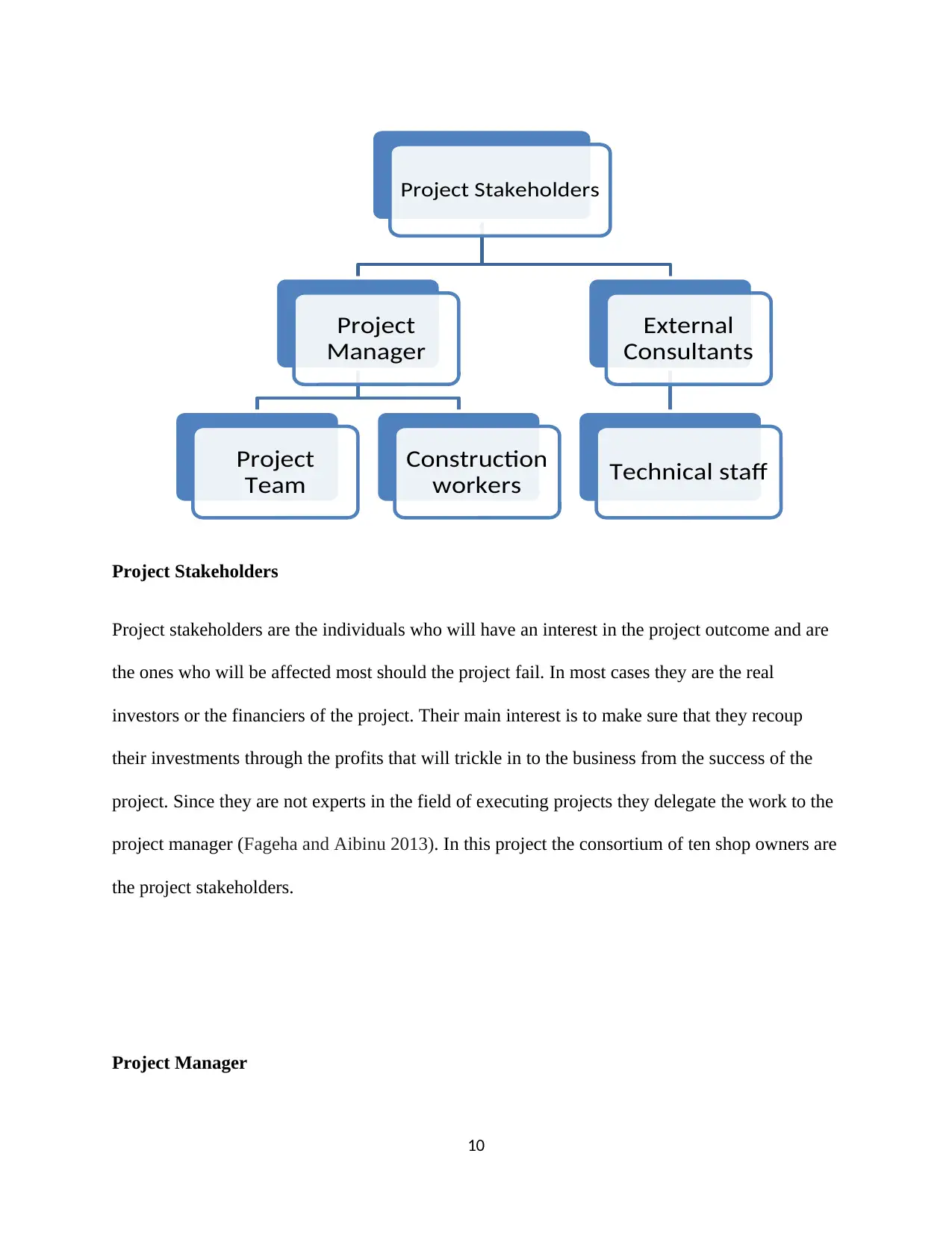
Project Stakeholders
Project stakeholders are the individuals who will have an interest in the project outcome and are
the ones who will be affected most should the project fail. In most cases they are the real
investors or the financiers of the project. Their main interest is to make sure that they recoup
their investments through the profits that will trickle in to the business from the success of the
project. Since they are not experts in the field of executing projects they delegate the work to the
project manager (Fageha and Aibinu 2013). In this project the consortium of ten shop owners are
the project stakeholders.
Project Manager
10
Project Stakeholders
Project
Manager
Project
Team
Construction
workers
External
Consultants
Technical staff
Project stakeholders are the individuals who will have an interest in the project outcome and are
the ones who will be affected most should the project fail. In most cases they are the real
investors or the financiers of the project. Their main interest is to make sure that they recoup
their investments through the profits that will trickle in to the business from the success of the
project. Since they are not experts in the field of executing projects they delegate the work to the
project manager (Fageha and Aibinu 2013). In this project the consortium of ten shop owners are
the project stakeholders.
Project Manager
10
Project Stakeholders
Project
Manager
Project
Team
Construction
workers
External
Consultants
Technical staff
Paraphrase This Document
Need a fresh take? Get an instant paraphrase of this document with our AI Paraphraser
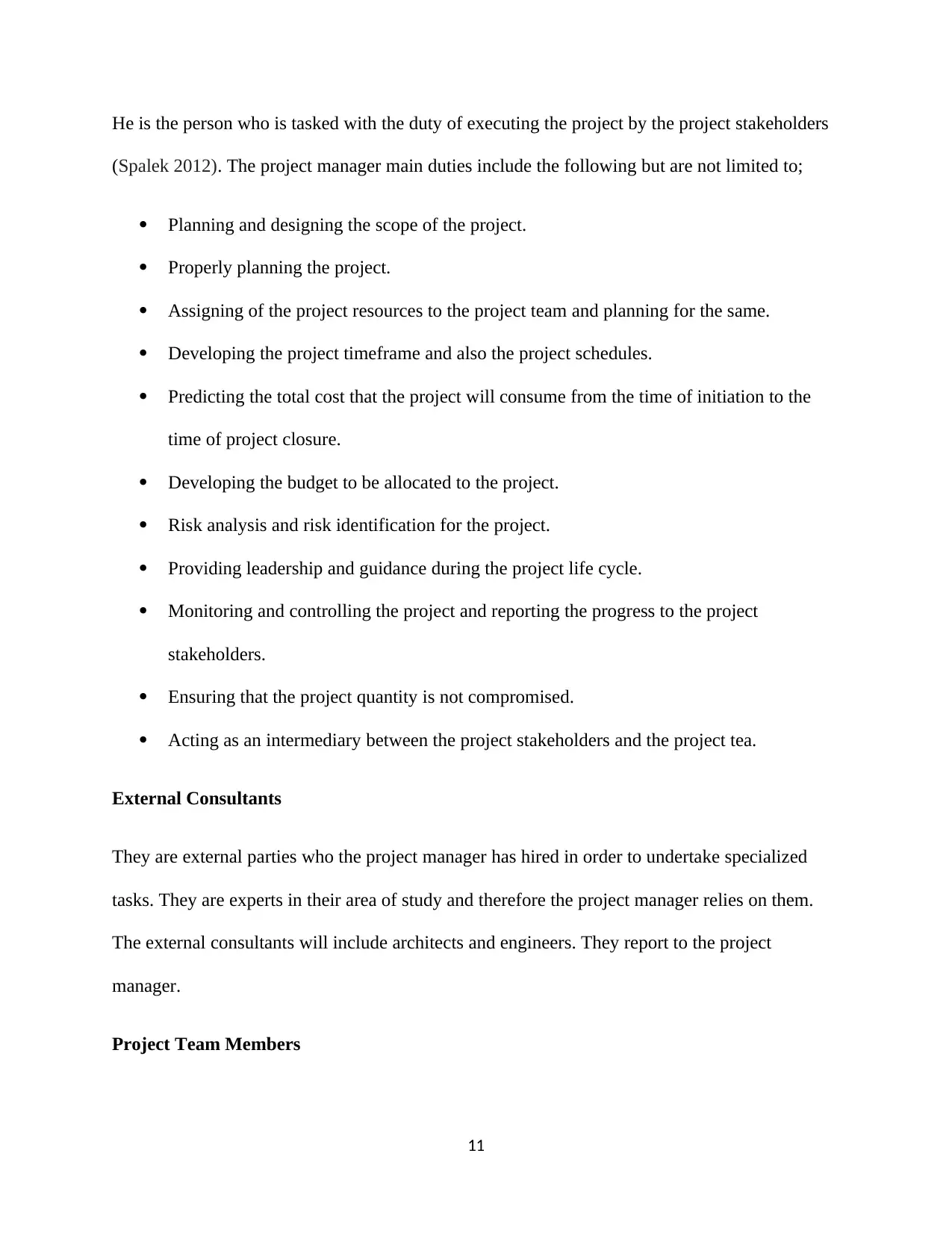
He is the person who is tasked with the duty of executing the project by the project stakeholders
(Spalek 2012). The project manager main duties include the following but are not limited to;
Planning and designing the scope of the project.
Properly planning the project.
Assigning of the project resources to the project team and planning for the same.
Developing the project timeframe and also the project schedules.
Predicting the total cost that the project will consume from the time of initiation to the
time of project closure.
Developing the budget to be allocated to the project.
Risk analysis and risk identification for the project.
Providing leadership and guidance during the project life cycle.
Monitoring and controlling the project and reporting the progress to the project
stakeholders.
Ensuring that the project quantity is not compromised.
Acting as an intermediary between the project stakeholders and the project tea.
External Consultants
They are external parties who the project manager has hired in order to undertake specialized
tasks. They are experts in their area of study and therefore the project manager relies on them.
The external consultants will include architects and engineers. They report to the project
manager.
Project Team Members
11
(Spalek 2012). The project manager main duties include the following but are not limited to;
Planning and designing the scope of the project.
Properly planning the project.
Assigning of the project resources to the project team and planning for the same.
Developing the project timeframe and also the project schedules.
Predicting the total cost that the project will consume from the time of initiation to the
time of project closure.
Developing the budget to be allocated to the project.
Risk analysis and risk identification for the project.
Providing leadership and guidance during the project life cycle.
Monitoring and controlling the project and reporting the progress to the project
stakeholders.
Ensuring that the project quantity is not compromised.
Acting as an intermediary between the project stakeholders and the project tea.
External Consultants
They are external parties who the project manager has hired in order to undertake specialized
tasks. They are experts in their area of study and therefore the project manager relies on them.
The external consultants will include architects and engineers. They report to the project
manager.
Project Team Members
11
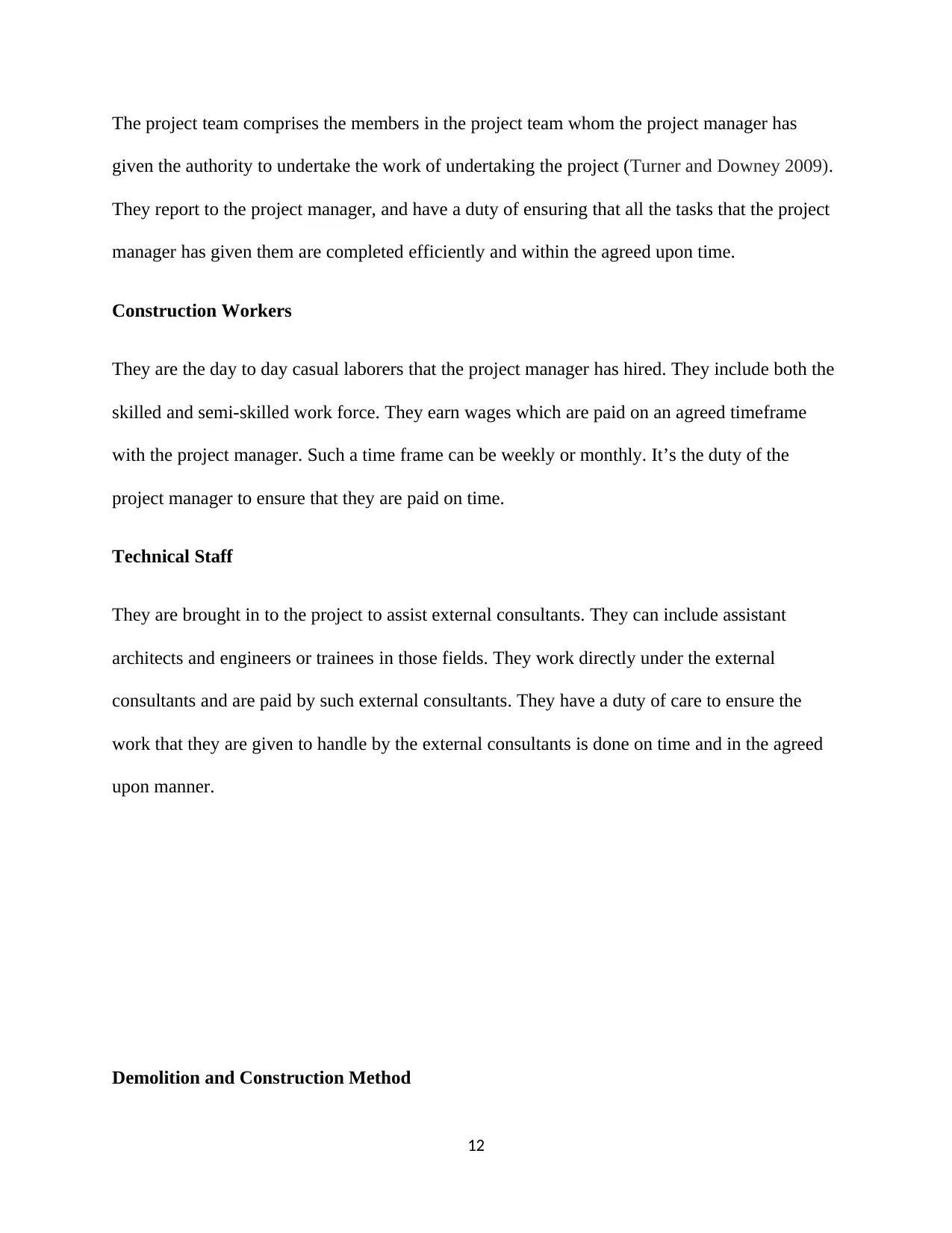
The project team comprises the members in the project team whom the project manager has
given the authority to undertake the work of undertaking the project (Turner and Downey 2009).
They report to the project manager, and have a duty of ensuring that all the tasks that the project
manager has given them are completed efficiently and within the agreed upon time.
Construction Workers
They are the day to day casual laborers that the project manager has hired. They include both the
skilled and semi-skilled work force. They earn wages which are paid on an agreed timeframe
with the project manager. Such a time frame can be weekly or monthly. It’s the duty of the
project manager to ensure that they are paid on time.
Technical Staff
They are brought in to the project to assist external consultants. They can include assistant
architects and engineers or trainees in those fields. They work directly under the external
consultants and are paid by such external consultants. They have a duty of care to ensure the
work that they are given to handle by the external consultants is done on time and in the agreed
upon manner.
Demolition and Construction Method
12
given the authority to undertake the work of undertaking the project (Turner and Downey 2009).
They report to the project manager, and have a duty of ensuring that all the tasks that the project
manager has given them are completed efficiently and within the agreed upon time.
Construction Workers
They are the day to day casual laborers that the project manager has hired. They include both the
skilled and semi-skilled work force. They earn wages which are paid on an agreed timeframe
with the project manager. Such a time frame can be weekly or monthly. It’s the duty of the
project manager to ensure that they are paid on time.
Technical Staff
They are brought in to the project to assist external consultants. They can include assistant
architects and engineers or trainees in those fields. They work directly under the external
consultants and are paid by such external consultants. They have a duty of care to ensure the
work that they are given to handle by the external consultants is done on time and in the agreed
upon manner.
Demolition and Construction Method
12
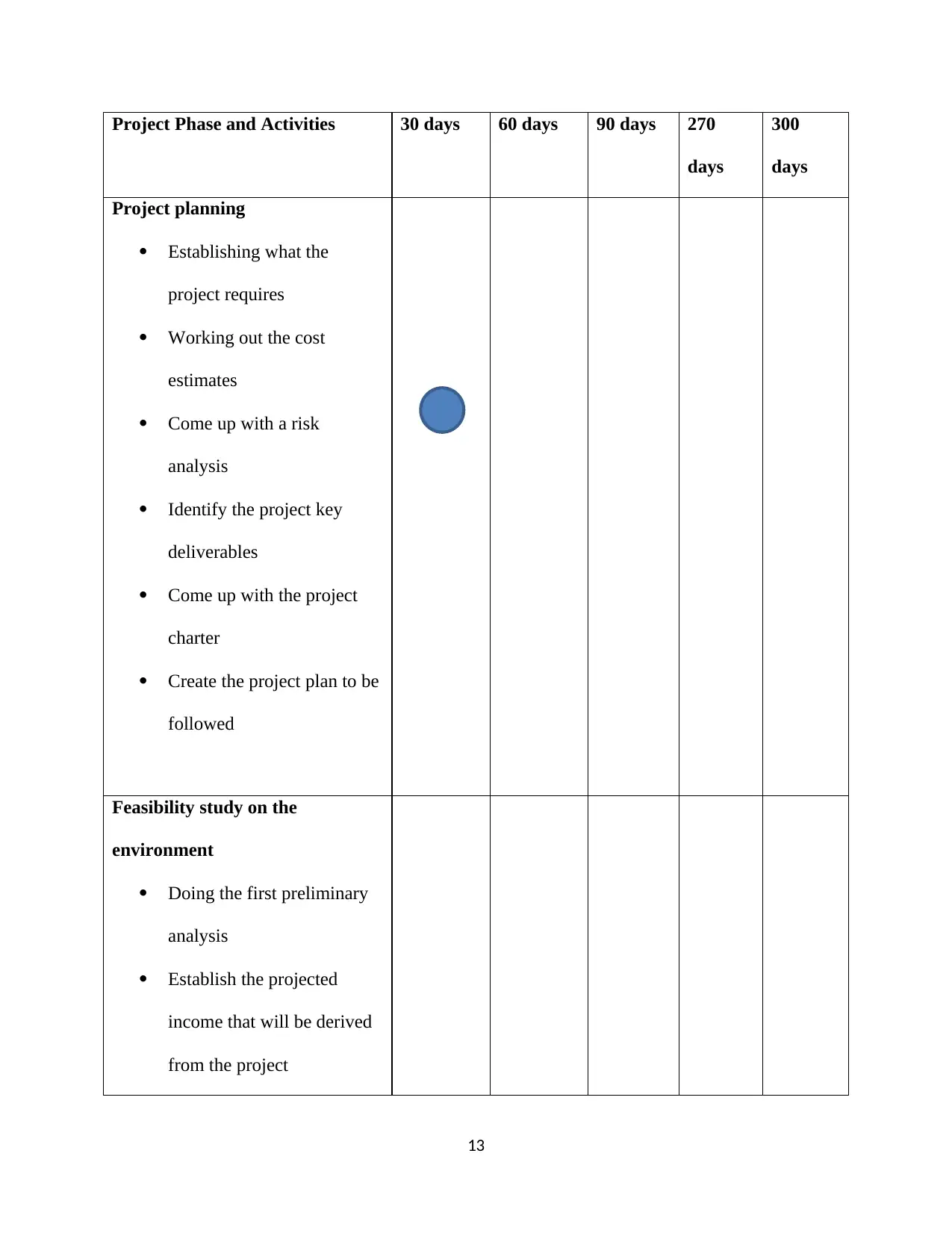
Project Phase and Activities 30 days 60 days 90 days 270
days
300
days
Project planning
Establishing what the
project requires
Working out the cost
estimates
Come up with a risk
analysis
Identify the project key
deliverables
Come up with the project
charter
Create the project plan to be
followed
Feasibility study on the
environment
Doing the first preliminary
analysis
Establish the projected
income that will be derived
from the project
13
days
300
days
Project planning
Establishing what the
project requires
Working out the cost
estimates
Come up with a risk
analysis
Identify the project key
deliverables
Come up with the project
charter
Create the project plan to be
followed
Feasibility study on the
environment
Doing the first preliminary
analysis
Establish the projected
income that will be derived
from the project
13
Secure Best Marks with AI Grader
Need help grading? Try our AI Grader for instant feedback on your assignments.
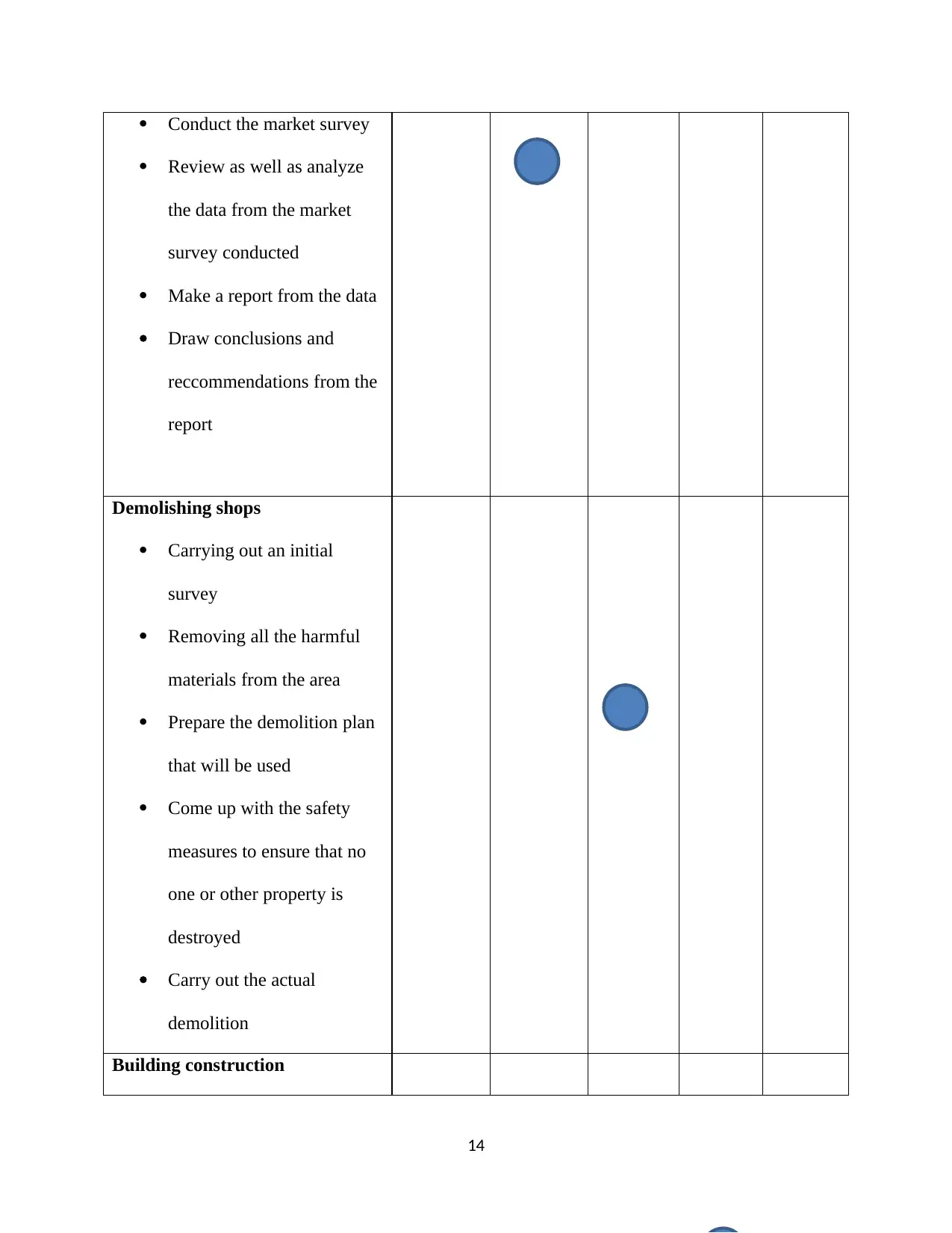
Conduct the market survey
Review as well as analyze
the data from the market
survey conducted
Make a report from the data
Draw conclusions and
reccommendations from the
report
Demolishing shops
Carrying out an initial
survey
Removing all the harmful
materials from the area
Prepare the demolition plan
that will be used
Come up with the safety
measures to ensure that no
one or other property is
destroyed
Carry out the actual
demolition
Building construction
14
Review as well as analyze
the data from the market
survey conducted
Make a report from the data
Draw conclusions and
reccommendations from the
report
Demolishing shops
Carrying out an initial
survey
Removing all the harmful
materials from the area
Prepare the demolition plan
that will be used
Come up with the safety
measures to ensure that no
one or other property is
destroyed
Carry out the actual
demolition
Building construction
14
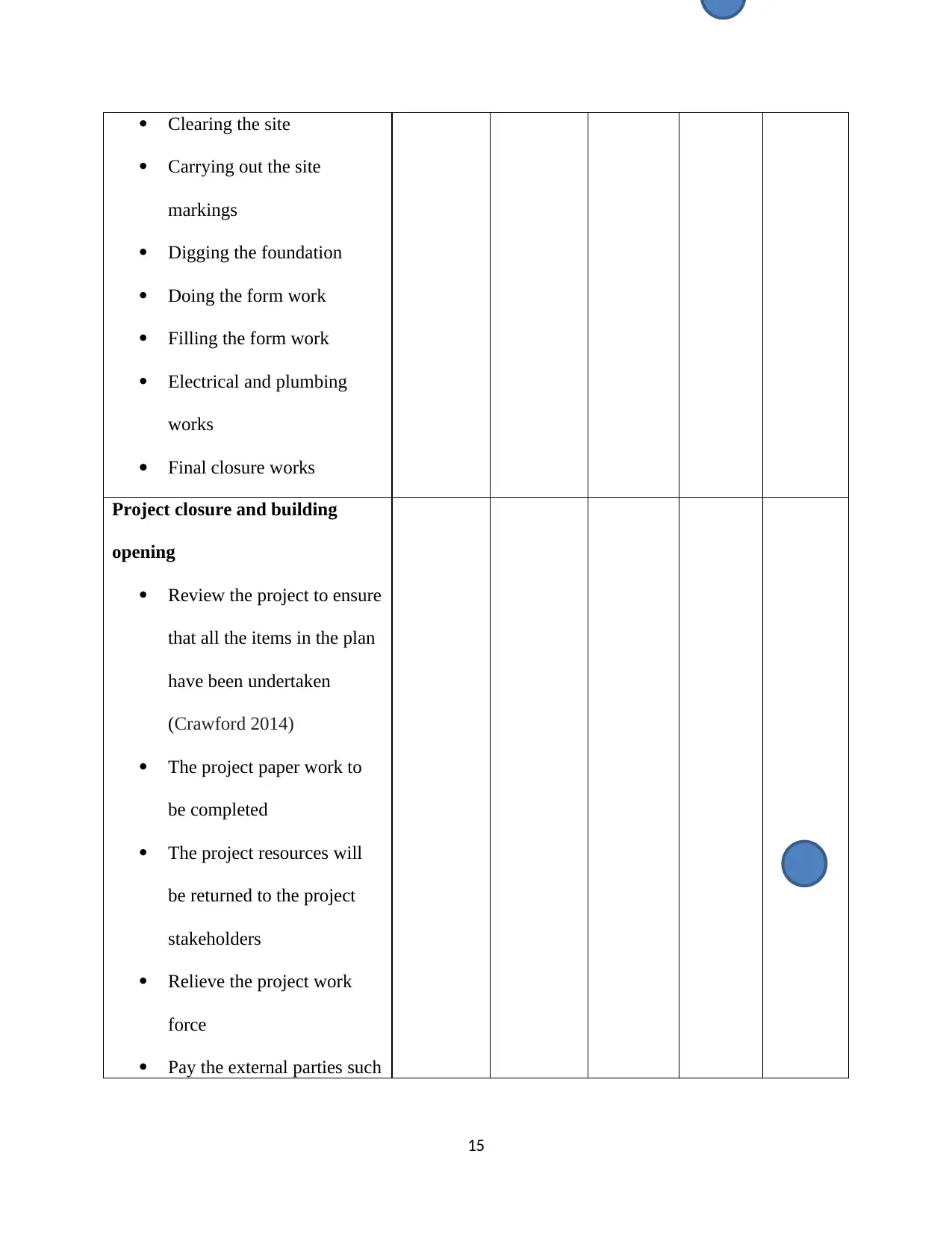
Clearing the site
Carrying out the site
markings
Digging the foundation
Doing the form work
Filling the form work
Electrical and plumbing
works
Final closure works
Project closure and building
opening
Review the project to ensure
that all the items in the plan
have been undertaken
(Crawford 2014)
The project paper work to
be completed
The project resources will
be returned to the project
stakeholders
Relieve the project work
force
Pay the external parties such
15
Carrying out the site
markings
Digging the foundation
Doing the form work
Filling the form work
Electrical and plumbing
works
Final closure works
Project closure and building
opening
Review the project to ensure
that all the items in the plan
have been undertaken
(Crawford 2014)
The project paper work to
be completed
The project resources will
be returned to the project
stakeholders
Relieve the project work
force
Pay the external parties such
15
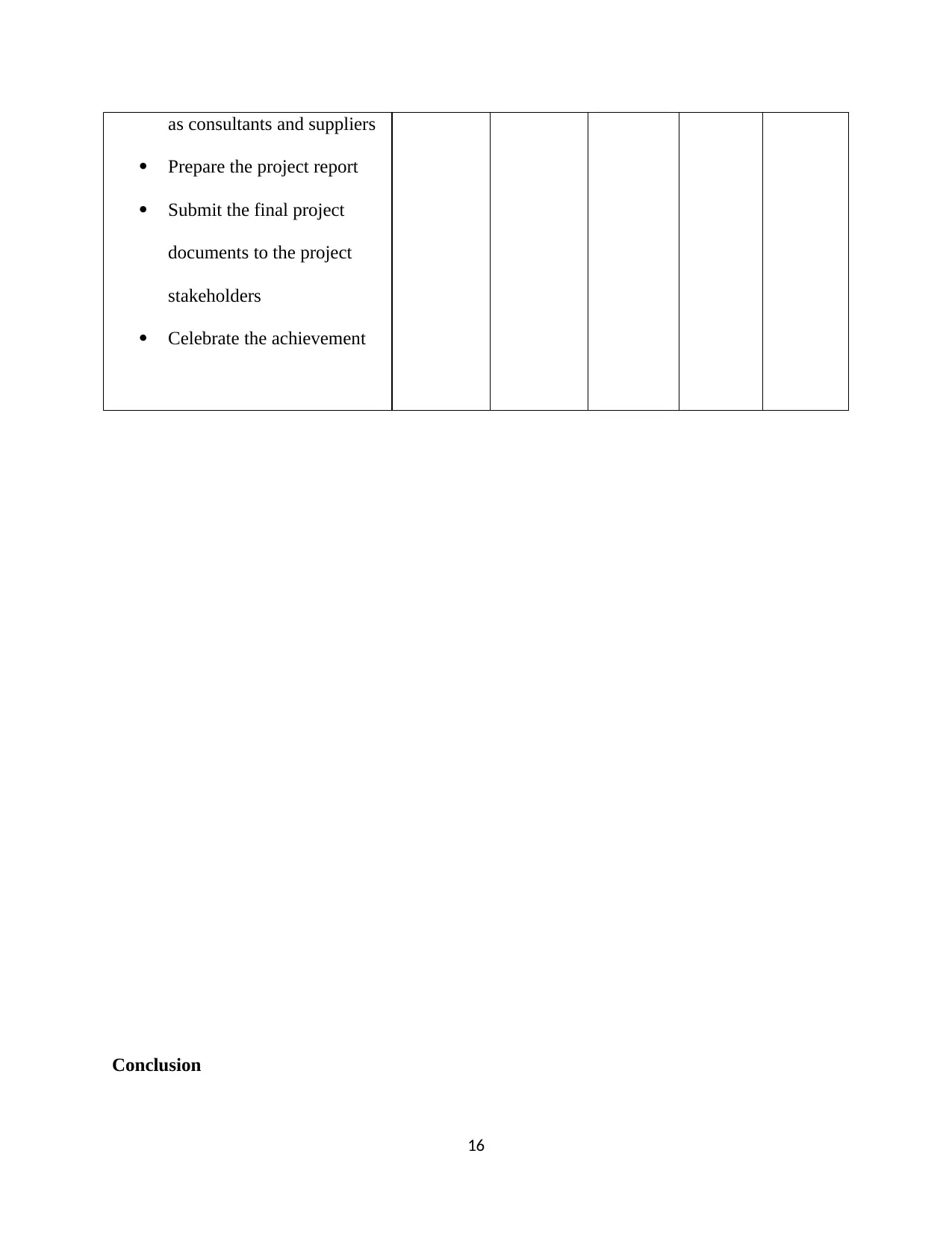
as consultants and suppliers
Prepare the project report
Submit the final project
documents to the project
stakeholders
Celebrate the achievement
Conclusion
16
Prepare the project report
Submit the final project
documents to the project
stakeholders
Celebrate the achievement
Conclusion
16
Paraphrase This Document
Need a fresh take? Get an instant paraphrase of this document with our AI Paraphraser
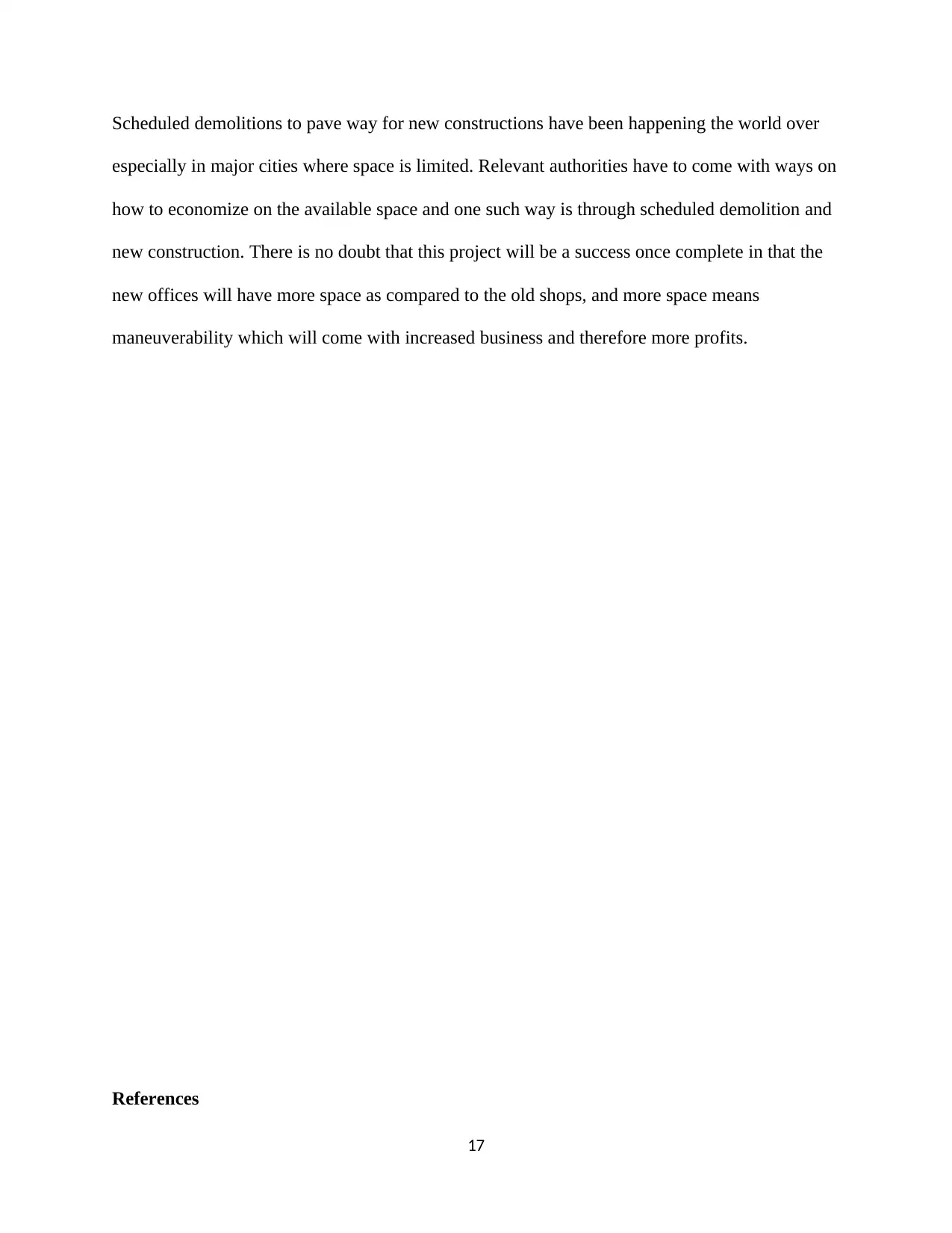
Scheduled demolitions to pave way for new constructions have been happening the world over
especially in major cities where space is limited. Relevant authorities have to come with ways on
how to economize on the available space and one such way is through scheduled demolition and
new construction. There is no doubt that this project will be a success once complete in that the
new offices will have more space as compared to the old shops, and more space means
maneuverability which will come with increased business and therefore more profits.
References
17
especially in major cities where space is limited. Relevant authorities have to come with ways on
how to economize on the available space and one such way is through scheduled demolition and
new construction. There is no doubt that this project will be a success once complete in that the
new offices will have more space as compared to the old shops, and more space means
maneuverability which will come with increased business and therefore more profits.
References
17
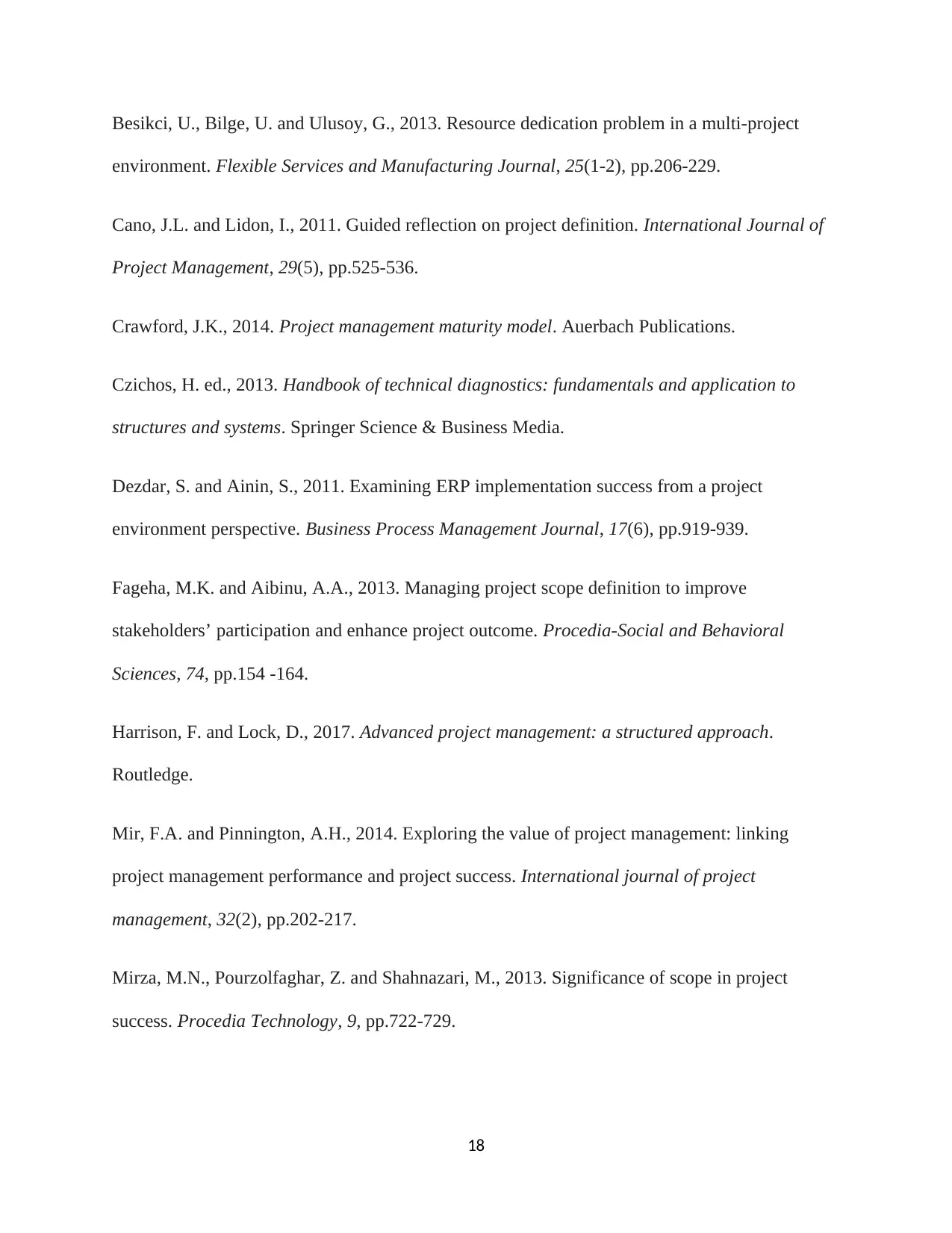
Besikci, U., Bilge, U. and Ulusoy, G., 2013. Resource dedication problem in a multi-project
environment. Flexible Services and Manufacturing Journal, 25(1-2), pp.206-229.
Cano, J.L. and Lidon, I., 2011. Guided reflection on project definition. International Journal of
Project Management, 29(5), pp.525-536.
Crawford, J.K., 2014. Project management maturity model. Auerbach Publications.
Czichos, H. ed., 2013. Handbook of technical diagnostics: fundamentals and application to
structures and systems. Springer Science & Business Media.
Dezdar, S. and Ainin, S., 2011. Examining ERP implementation success from a project
environment perspective. Business Process Management Journal, 17(6), pp.919-939.
Fageha, M.K. and Aibinu, A.A., 2013. Managing project scope definition to improve
stakeholders’ participation and enhance project outcome. Procedia-Social and Behavioral
Sciences, 74, pp.154 -164.
Harrison, F. and Lock, D., 2017. Advanced project management: a structured approach.
Routledge.
Mir, F.A. and Pinnington, A.H., 2014. Exploring the value of project management: linking
project management performance and project success. International journal of project
management, 32(2), pp.202-217.
Mirza, M.N., Pourzolfaghar, Z. and Shahnazari, M., 2013. Significance of scope in project
success. Procedia Technology, 9, pp.722-729.
18
environment. Flexible Services and Manufacturing Journal, 25(1-2), pp.206-229.
Cano, J.L. and Lidon, I., 2011. Guided reflection on project definition. International Journal of
Project Management, 29(5), pp.525-536.
Crawford, J.K., 2014. Project management maturity model. Auerbach Publications.
Czichos, H. ed., 2013. Handbook of technical diagnostics: fundamentals and application to
structures and systems. Springer Science & Business Media.
Dezdar, S. and Ainin, S., 2011. Examining ERP implementation success from a project
environment perspective. Business Process Management Journal, 17(6), pp.919-939.
Fageha, M.K. and Aibinu, A.A., 2013. Managing project scope definition to improve
stakeholders’ participation and enhance project outcome. Procedia-Social and Behavioral
Sciences, 74, pp.154 -164.
Harrison, F. and Lock, D., 2017. Advanced project management: a structured approach.
Routledge.
Mir, F.A. and Pinnington, A.H., 2014. Exploring the value of project management: linking
project management performance and project success. International journal of project
management, 32(2), pp.202-217.
Mirza, M.N., Pourzolfaghar, Z. and Shahnazari, M., 2013. Significance of scope in project
success. Procedia Technology, 9, pp.722-729.
18
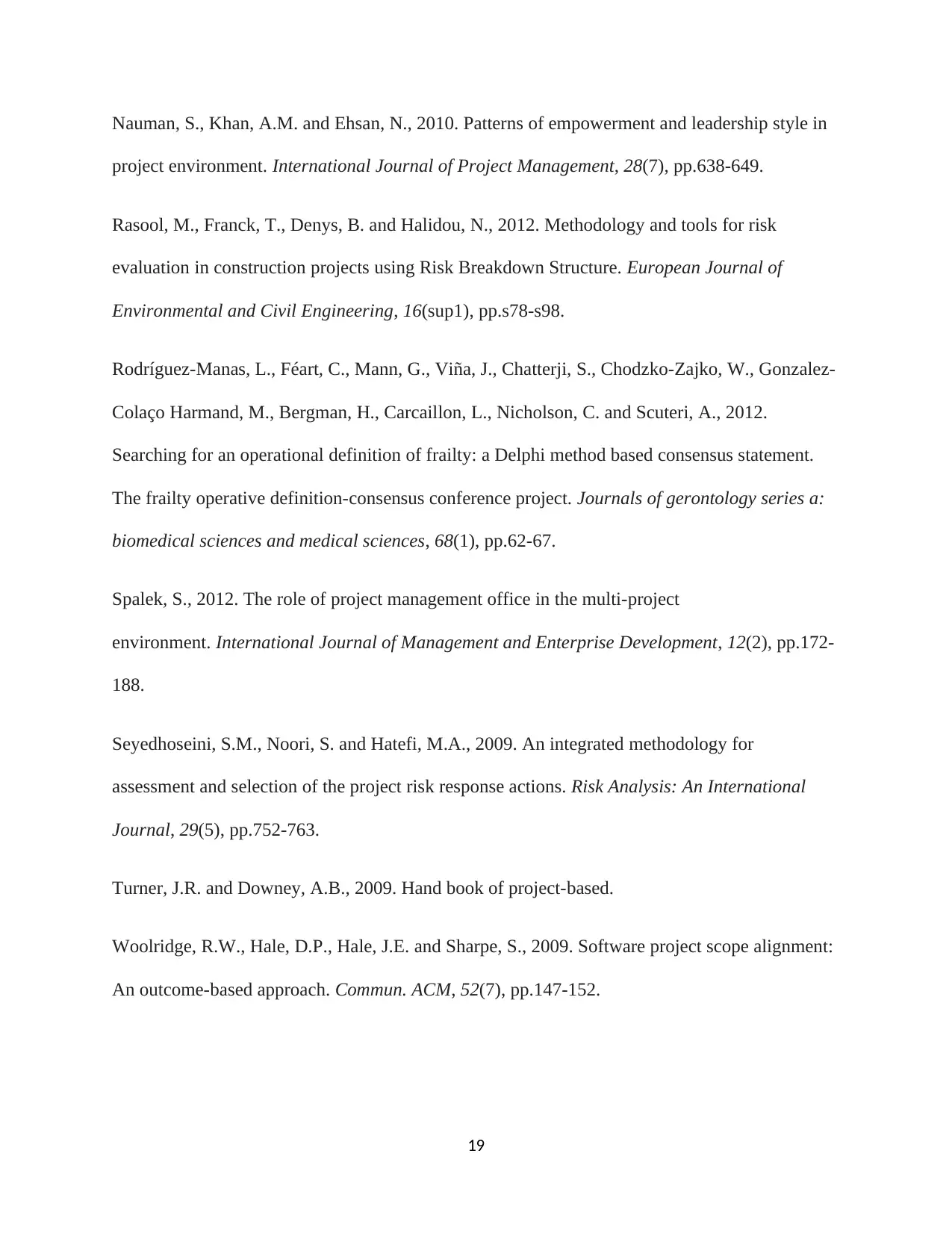
Nauman, S., Khan, A.M. and Ehsan, N., 2010. Patterns of empowerment and leadership style in
project environment. International Journal of Project Management, 28(7), pp.638-649.
Rasool, M., Franck, T., Denys, B. and Halidou, N., 2012. Methodology and tools for risk
evaluation in construction projects using Risk Breakdown Structure. European Journal of
Environmental and Civil Engineering, 16(sup1), pp.s78-s98.
Rodríguez-Manas, L., Féart, C., Mann, G., Viña, J., Chatterji, S., Chodzko-Zajko, W., Gonzalez-
Colaço Harmand, M., Bergman, H., Carcaillon, L., Nicholson, C. and Scuteri, A., 2012.
Searching for an operational definition of frailty: a Delphi method based consensus statement.
The frailty operative definition-consensus conference project. Journals of gerontology series a:
biomedical sciences and medical sciences, 68(1), pp.62-67.
Spalek, S., 2012. The role of project management office in the multi-project
environment. International Journal of Management and Enterprise Development, 12(2), pp.172-
188.
Seyedhoseini, S.M., Noori, S. and Hatefi, M.A., 2009. An integrated methodology for
assessment and selection of the project risk response actions. Risk Analysis: An International
Journal, 29(5), pp.752-763.
Turner, J.R. and Downey, A.B., 2009. Hand book of project-based.
Woolridge, R.W., Hale, D.P., Hale, J.E. and Sharpe, S., 2009. Software project scope alignment:
An outcome-based approach. Commun. ACM, 52(7), pp.147-152.
19
project environment. International Journal of Project Management, 28(7), pp.638-649.
Rasool, M., Franck, T., Denys, B. and Halidou, N., 2012. Methodology and tools for risk
evaluation in construction projects using Risk Breakdown Structure. European Journal of
Environmental and Civil Engineering, 16(sup1), pp.s78-s98.
Rodríguez-Manas, L., Féart, C., Mann, G., Viña, J., Chatterji, S., Chodzko-Zajko, W., Gonzalez-
Colaço Harmand, M., Bergman, H., Carcaillon, L., Nicholson, C. and Scuteri, A., 2012.
Searching for an operational definition of frailty: a Delphi method based consensus statement.
The frailty operative definition-consensus conference project. Journals of gerontology series a:
biomedical sciences and medical sciences, 68(1), pp.62-67.
Spalek, S., 2012. The role of project management office in the multi-project
environment. International Journal of Management and Enterprise Development, 12(2), pp.172-
188.
Seyedhoseini, S.M., Noori, S. and Hatefi, M.A., 2009. An integrated methodology for
assessment and selection of the project risk response actions. Risk Analysis: An International
Journal, 29(5), pp.752-763.
Turner, J.R. and Downey, A.B., 2009. Hand book of project-based.
Woolridge, R.W., Hale, D.P., Hale, J.E. and Sharpe, S., 2009. Software project scope alignment:
An outcome-based approach. Commun. ACM, 52(7), pp.147-152.
19
1 out of 22
Related Documents
Your All-in-One AI-Powered Toolkit for Academic Success.
+13062052269
info@desklib.com
Available 24*7 on WhatsApp / Email
![[object Object]](/_next/static/media/star-bottom.7253800d.svg)
Unlock your academic potential
© 2024 | Zucol Services PVT LTD | All rights reserved.





